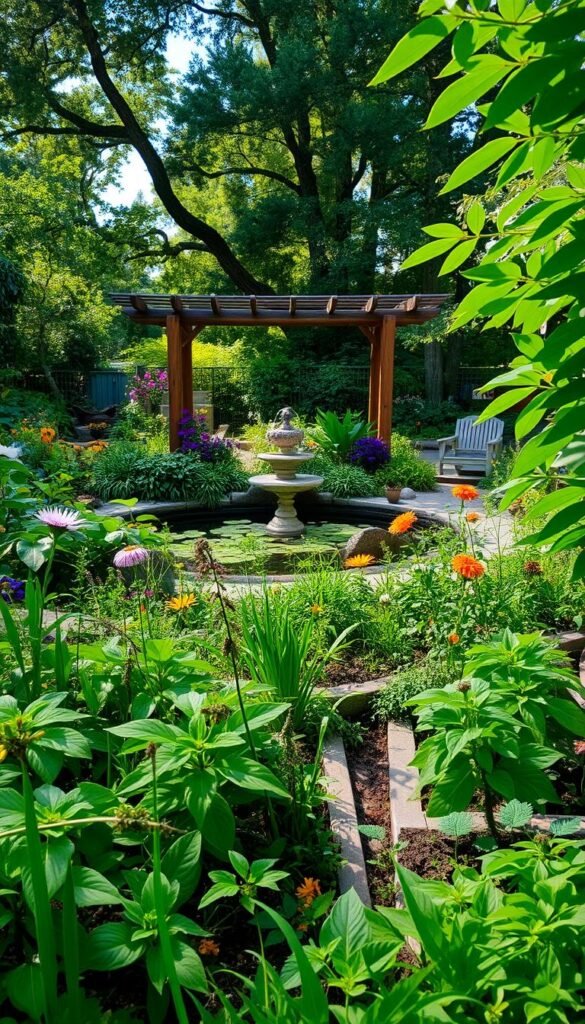Imagine stepping into an outdoor space where every plant serves a purpose. These thriving landscapes blend beauty with practical sustainability, creating habitats that buzz with life while conserving resources. Unlike traditional setups, this approach works with local ecosystems—not against them—to build resilience and reduce your environmental footprint.
You’ll learn how simple swaps, like choosing native plants or organic soil treatments, can revive your yard’s health. Studies show these methods cut water use by up to 50% while attracting pollinators like bees and butterflies. Even the EPA highlights how such practices lower pollution and support wildlife—proof that small changes create big impacts.
Think of your plot as a living canvas that evolves with the seasons. By elevating your outdoor space through thoughtful design, you craft more than visuals—you nurture a self-sustaining retreat. It’s about balancing human enjoyment with nature’s rhythms, turning ordinary soil into a vibrant ecosystem.
Ready to transform how you garden? Let’s explore how intentional choices can turn your yard into a sanctuary that gives back to the earth—and inspires everyone who visits it.
Envisioning Your Sustainable Garden Oasis
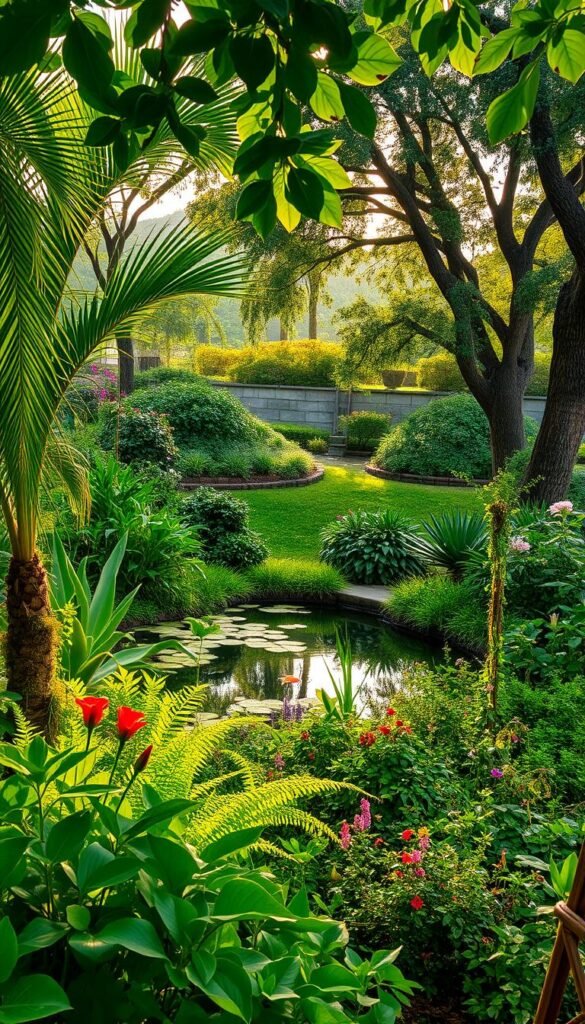
Your backyard can become a sanctuary that supports the planet. Start by defining what sustainability means for your space—whether conserving water, nurturing pollinators, or growing fresh herbs. This mindset shift turns ordinary yards into living systems that benefit both people and the environment.
Setting Your Eco-Friendly Intentions
Ask yourself: What role should nature play here? Maybe you want to reduce runoff with permeable pathways or replace high-maintenance grass with budget-friendly native ground covers. List three priorities, like improving soil health or creating wildlife shelters. These choices become your roadmap.
Crafting a Vision That Inspires
Balance practicality with aesthetics by sketching layouts that incorporate edible plants alongside flowers. Imagine lavender borders buzzing with bees or rain barrels feeding vegetable beds. Use this table to compare traditional vs. sustainable approaches:
| Feature | Conventional Garden | Sustainable Design |
|---|---|---|
| Water Source | Municipal supply | Rainwater collection |
| Soil Treatment | Synthetic fertilizers | Compost & mulch |
| Wildlife Impact | Limited habitat | Supports 5+ species |
Revisit your plan each season. As native plants establish and compost enriches the soil, you’ll see your oasis evolve—proof that thoughtful design creates lasting beauty.
Embracing Water-Wise Landscaping
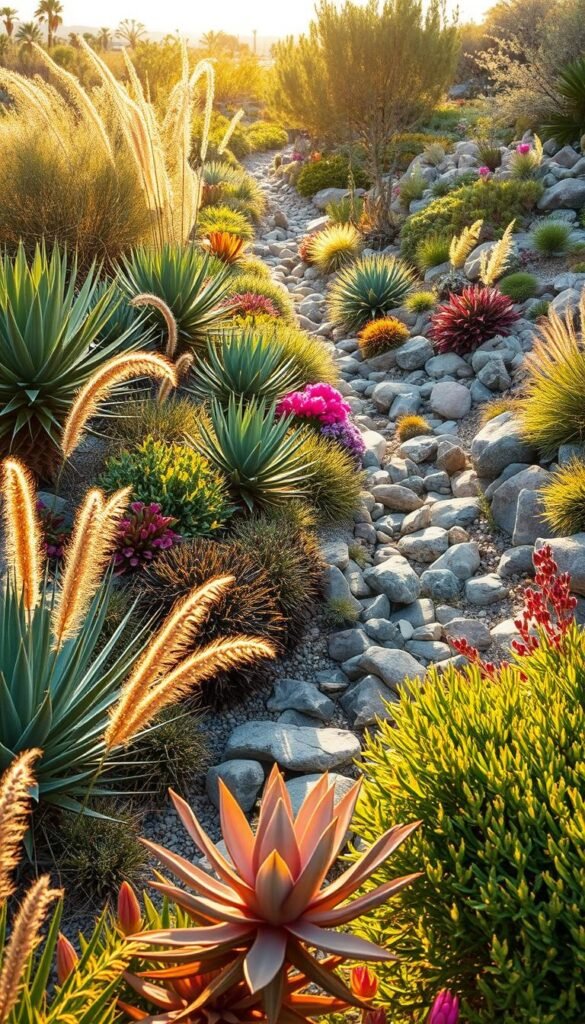
Revolutionize your outdoor space by rethinking how every drop counts. Water-wise landscaping combines smart design with resilient plants to create vibrant spaces that thrive on less water. This method works particularly well in drier climates but benefits any region looking to reduce resource use.
Drip Irrigation and Rainwater Harvesting
Upgrade your watering strategy with targeted systems. Drip lines send moisture straight to roots, cutting waste by 60% compared to sprinklers. Pair this with rain barrels to capture free hydration from storms—a single inch of rain can collect 600 gallons from a typical roof.
| Method | Water Savings | Setup Cost |
|---|---|---|
| Traditional Sprinklers | 0% | $100-$300 |
| Drip Systems | 50-70% | $200-$500 |
| Rain Barrels | 30-50% | $50-$150 |
Maximizing Water Conservation
Group plants by their hydration needs. Drought-loving agaves and lavender flourish in sunny spots, while moisture-sensitive ferns belong in shaded areas. Add 3 inches of mulch around beds to lock in dampness naturally.
Consider contouring your land with shallow trenches (swales) that guide rain toward thirsty plants. These techniques help your landscaping survive dry spells while keeping maintenance low. You’ll spend less time watering and more time enjoying your resilient oasis.
Choosing Native Plants for a Thriving Ecosystem
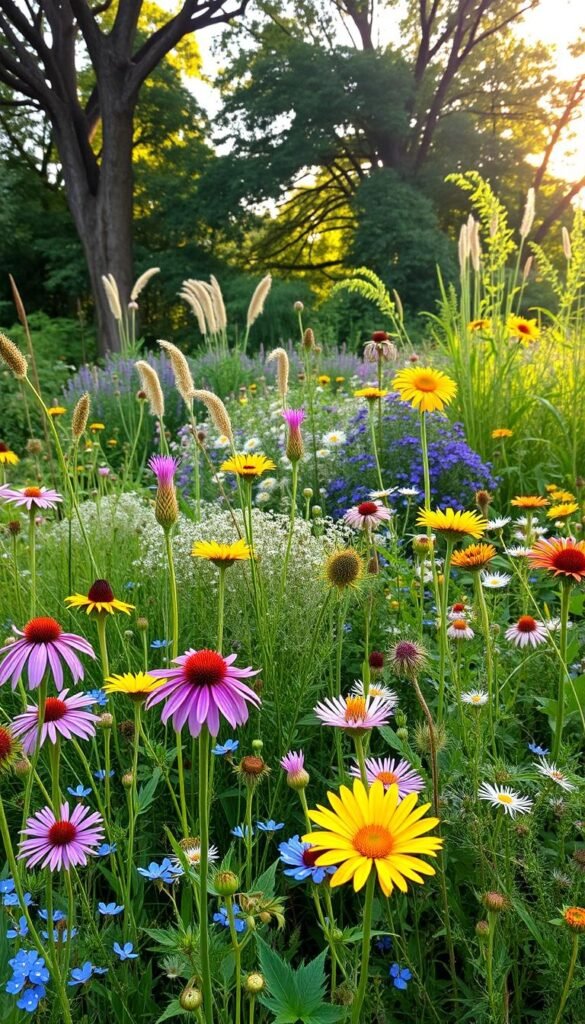
Unlock the secret to low-maintenance beauty with plants that belong. Species naturally found in your region evolved alongside local weather patterns and soil types, making them champions of resilience. They form the foundation of healthy ecosystems, supporting intricate relationships between insects, birds, and microorganisms.
Why Local Flora Outperforms Imports
Native species need fewer resources to thrive. Their deep roots access groundwater during droughts, and their natural pest defenses reduce chemical needs. Compare their advantages:
| Characteristic | Native Plants | Non-Native Plants |
|---|---|---|
| Water Needs | Adapted to rainfall | Often need irrigation |
| Pest Resistance | High | Low |
| Wildlife Value | Supports 8x more species | Limited benefits |
Designing Habitats That Welcome Life
Select flowering varieties like milkweed or coneflower to feed butterflies. Berry-producing shrubs shelter birds while adding seasonal color. Cluster plants in groups to mimic natural growth patterns, creating safe corridors for local wildlife.
Check with your state’s native plant society for species recommendations. Many offer interactive tools to match plants with your yard’s sunlight and soil conditions. You’ll create a living network that sustains itself—and your community’s biodiversity.
Sustainable Hardscaping with Eco-Friendly Materials
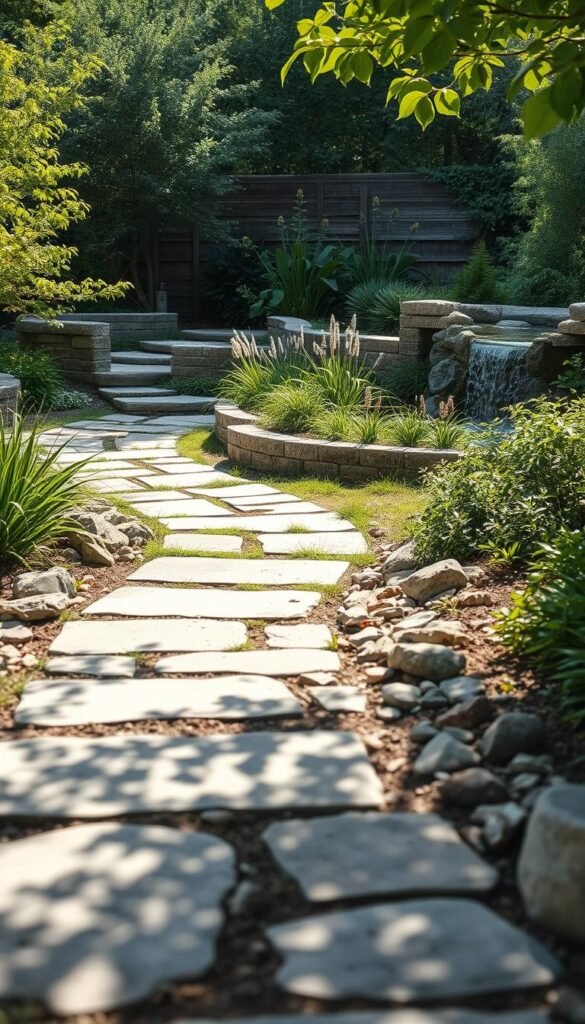
Transform your outdoor spaces with materials that do double duty—beautiful and earth-conscious. Paths, patios, and borders become eco-assets when built using reclaimed bricks, permeable pavers, or locally sourced stone. These choices reduce waste, manage water flow, and blend seamlessly with nature’s rhythms.
Reclaimed Bricks and Permeable Pavers
Give old bricks new life as charming walkways or garden edging. Each repurposed piece keeps construction debris out of landfills while adding rustic character. Pair them with permeable pavers—interlocking stones that let rainwater soak into the soil instead of flooding drains.
| Material | Environmental Benefit | Best Use |
|---|---|---|
| Reclaimed Brick | Reduces landfill waste | Pathways, borders |
| Permeable Pavers | Prevents runoff | Patios, driveways |
| Local Stone | Cuts transportation emissions | Retaining walls |
Designing with Natural Stone and Wood
Choose regional stone for walls or decorative accents—it weathers beautifully and supports nearby quarries. For wood structures, opt for reclaimed barn boards or FSC-certified timber. These options resist rot naturally, avoiding toxic treatments.
Combine textures for visual harmony: gravel paths beside smooth slate benches, or rough-hewn logs paired with polished river rocks. This approach mirrors the whimsical garden pathways found in cottagecore designs, proving sustainability and style coexist effortlessly.
Rethinking Traditional Lawn for Sustainability
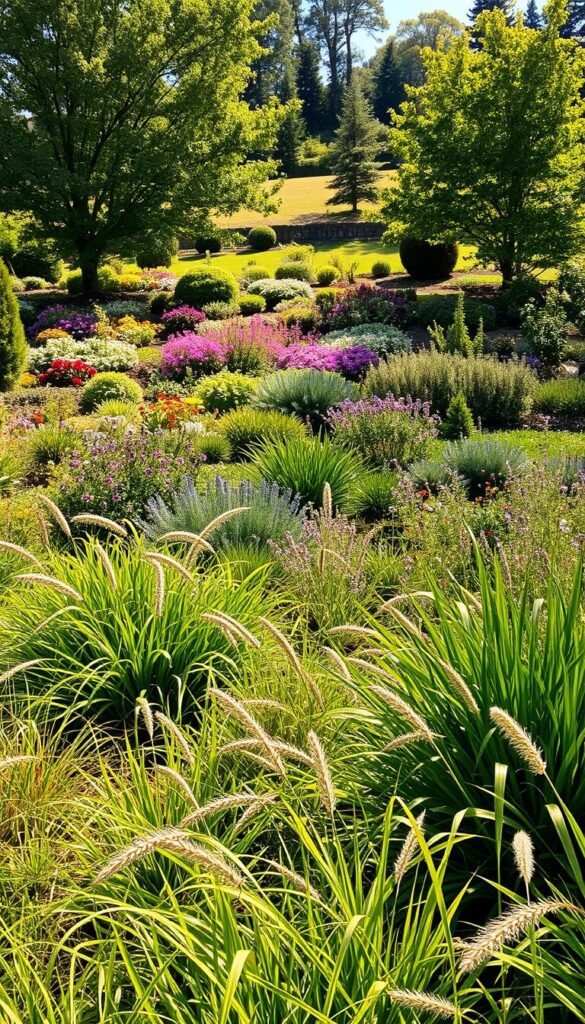
What if your lawn could care for itself? Conventional grass demands endless watering, weekly mowing, and chemical cocktails to stay green. These resource-heavy practices drain time and harm local ecosystems through pesticide runoff and water waste.
Low-Maintenance Alternatives to Grass
Clover emerges as a superstar replacement. Its deep roots access moisture during droughts, staying lush with less water. Unlike grass, it naturally fertilizes soil by fixing nitrogen—no synthetic products needed. Bonus: bees adore its tiny blooms.
| Feature | Traditional Lawn | Eco-Alternatives |
|---|---|---|
| Water Needs | High | Low |
| Mowing Frequency | Weekly | Monthly |
| Chemical Use | Required | None |
Introducing Clover Carpets and Native Grasses
For texture variety, consider native grasses like buffalo grass or blue grama. They thrive in regional climates, needing minimal care once established. Pair them with creeping thyme between stepping stones for fragrant ground cover that withstands foot traffic.
Transitioning your yard starts simple: kill existing grass with cardboard sheets, then seed clover or native mixes. Within months, your backyard becomes a self-sustaining tapestry that saves money and supports biodiversity. Why mow when you can marvel?
Composting and Soil Health: Nature’s Recycling Program
Turn your leftovers into garden gold. Composting transforms everyday kitchen scraps and yard trimmings into powerhouse nutrients for your plants. This natural process feeds soil while slashing household waste—a win-win for your yard and the planet.
Transforming Kitchen Scraps into Nutrient-Rich Compost
Start with a 3:1 mix of “browns” (dead leaves, cardboard) and “greens” (fruit peels, coffee grounds). Browns provide carbon, while greens deliver nitrogen—the fuel microbes need to break down materials. Keep the pile moist as a wrung-out sponge, turning it weekly for airflow.
Apartment dwellers can try compact tumblers or upcycled containers for space-saving solutions. Outdoor enthusiasts might prefer three-bin systems for continuous production. Worm composting works year-round, with red wigglers devouring scraps twice their weight daily.
Healthy soil teems with life when fed compost. It holds 20% more water and releases nutrients slowly—no synthetic fertilizers needed. Your plants get steady meals, and you keep 30% of trash out of landfills. Troubleshooting tip: If your pile smells, add more browns. Too dry? Toss in veggie peels.
Inviting Pollinators and Local Wildlife Home
Your yard could become a bustling hub for nature’s hardest workers. By designing spaces that cater to bees, butterflies, and birds, you’ll boost biodiversity while enjoying dynamic outdoor scenes. These creatures don’t just visit—they actively maintain your landscape’s health.
Building a Habitat That Buzzes With Life
Start with staggered bloom times. Plant early-spring crocuses, summer-blooming coneflowers, and fall asters to provide continuous nectar. This approach ensures local wildlife finds food through every season. Pair flowering varieties with host plants like milkweed—critical for monarch caterpillars.
| Feature | Pollinator Garden | Conventional Garden |
|---|---|---|
| Plant Selection | Native species with varied bloom times | Non-native ornamentals |
| Water Sources | Shallow dishes, birdbaths | None |
| Pesticide Use | Natural pest control | Chemical treatments |
Add water stations using pebble-filled dishes or DIY birdbaths from repurposed materials. Change water every three days to prevent mosquitoes. For shelter, stack fallen branches into brush piles or install bee hotels with bamboo tubes.
“A single mason bee can pollinate as much as 100 honeybees—proof that small habitats create big impacts.”
Swap pesticides for companion planting. Marigolds deter aphids near tomatoes, while dill attracts predatory wasps that eat caterpillars. In winter, leave seed heads standing and provide unfrozen water. Your efforts will ripple through the ecosystem, supporting wildlife far beyond your property line.
For detailed plant pairings, explore this guide to native flowering plants. You’ll discover how simple choices—like grouping purple coneflowers with black-eyed Susans—create irresistible pit stops for traveling pollinators.
Innovative Eco Garden Decor Ideas
Breathing new life into old objects isn’t just crafty—it’s a revolution in outdoor design. Your space becomes a gallery of sustainability where materials destined for landfills find new purpose. This approach turns everyday waste into functional art that sparks conversations and nurtures nature.
Upcycled Planters and DIY Projects
That cracked teapot? Perfect for succulents. Old rain boots? Ideal herb containers. Wooden pallets become vertical herb walls with minimal effort—just add soil and seedlings. Solar-powered lights strung through trellises create evening magic while cutting energy use.
Artistic Touches with Recycled Materials
Transform glass bottles into hummingbird feeders using copper wire hangers. Paint river rocks as plant markers or arrange them into winding paths. Rain chains made from repurposed spoons guide water melodically into barrels, blending sound and function.
These ideas prove creativity trumps consumerism. Each piece tells a story of renewal, inviting life into your space through thoughtful reinvention. Your outdoor area becomes a testament to how materials can evolve, not just exist.

